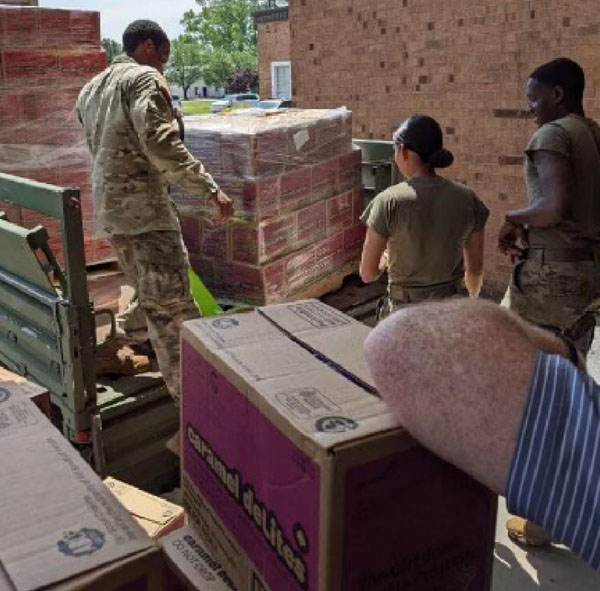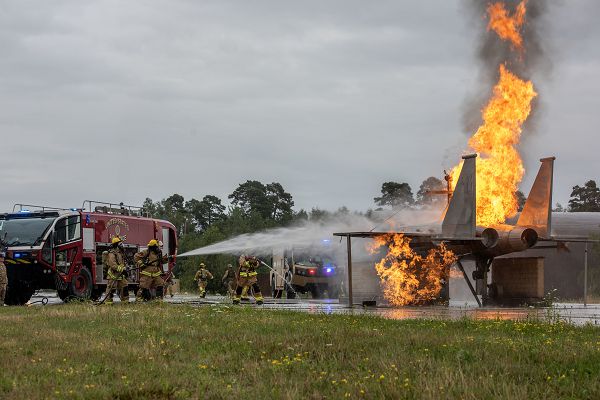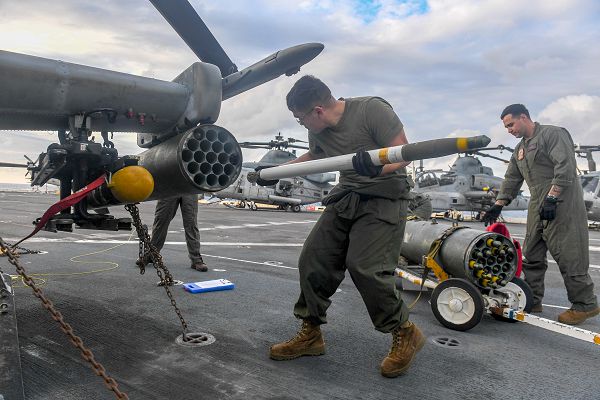- Details
- Hits: 554

Palawan, Philippines. (August 3, 2023): In this photo by Lance Corporal Juan Torres, Private First-Class Justin O’Neal and Lance Corporal Ignacio Aginaga, machine gunners with 2nd Battalion, 5th Marine Regiment, 1st Marine Division fire their M2A1 50 caliber machine gun during live fire exercises during Marine Aviation Support Activity 23. This semi-annual Philippine/U.S. training exercise includes live fire events involving heavy machine guns like the M2A1 50 Caliber.
These young Marines probably do not know it, but they are lugging around a weapon with a rich history of saving lives in battle. Developed in 1918, 50 caliber was the brainchild of John Moses Browning, an American firearm designer who developed a wide array of military firearms, cartridges, and gun mechanisms. The son of a gun store owner, young Browning made his first firearm at age 13, and he would go on to develop one of the most reliable and devastating weapons in modern warfare, the 50-caliber machine gun.
During World War II, soldiers marveled at the power and punch of the Browning M2 calling it the “Mother of All Machine Guns” or simply “Ma Deuce”. The M2 has been used extensively as a vehicle weapon and for aircraft armament by the United States since the 1930s. It was heavily used during World War II, the Korean War, the Vietnam War, the Falklands War, the Soviet–Afghan War, the Gulf War, the Iraq War, and the War in Afghanistan. It is the primary heavy machine gun of NATO countries and has been used by many other countries as well.
- Details
- Hits: 600

U.S., August 9, 2023 - Care goods are loaded for 900+ deploying service members the week of the 1st. One of several. All made possible by your donations. Your SOT Team focuses solely on serving the active duty servicemembers who are serving all of us. In America, all good comes from those who rise to the occasion and you have clearly done. They deliver for us -- we deliver for them. A simple moral equation.
All Together Now!®
- Details
- Hits: 553

Okinawa, Japan. (July 28, 2023): In this photo by Lance Corporal Say Ford, Marines with Medium Tiltrotor Squadron 265, 1st Marine Aircraft Wing evaluate a prototype loading system designed to allow the M142 High Mobility Rocket System (HIMARS) to be transported by the MV-22B Osprey tiltrotor aircraft. This modern design was the handiwork of Gunnery Sergeant Rodrigo Hernandez-Polindara, an active-duty Marine whose invention could lead to a more efficient way to transport the vital HIMARS system to the battlefield.
The devastating impact of HIMARS has been demonstrated recently by Ukraine which has used the system effectively to push back against numerically superior Russian forces. HIMARS was originally developed in the 1990s for the Army as a mobile artillery system but has since been used for anti-aircraft protection and long-range precision strikes. For infantry forces. HMARS is mounted onto a five-ton truck and it carries either six Guided Multiple Launch Rocket System rockets or one Army Tactical Missile System missile.
- Details
- Hits: 603

Santa Barbara, California. (July 29, 2023): Most Americans envision the Coast Guard seizing bad guys and rescuing folks at sea, but most do not realize the vital role this service plays in responding to oil spill disasters.
In this photo by Petty Officer 3rd Class Richard Uranga, a team of specialists from the U.S. Coast Guard, National Oceanic and Atmospheric Administration (NOAA), and federal Water Mapping experts undergo advanced drone training aboard the USCG Cutter Blackfin. The week-long training involved using Unmanned Aerial Systems (UAS) to collect test images of oil spills to quickly evaluate the impact and the response needs of actual oil spill incidents.
In fact, the Federal Water Pollution Control Act requires the Coast Guard to contain and clean up oil spills in coastal waters and to minimize the environmental damages. In this role, the Coast Guard prepares regional and local contingency plans for how to respond to oil spills involving multiple state and local jurisdictions.
The advent of unmanned aerials systems has added an extremely powerful tool to accelerate emergency response to oil disasters. The Coast Guard deploys the Predator drone for use at sea and the smaller, shorter range, Scan Eagle from its cutters. The service also employs the larger, more versatile, MQ-9 Reaper Guardian to assist Customs and Border Protection with aerial surveillance.
- Details
- Hits: 608

Ramstein Air Base, Germany. (July 27, 2023): The United States enjoys air superiority, not just because of its advanced aircraft, but also through the skillful use of the shovel and the trowel. Because of U.S. advanced air power, the enemy will likely target our airfields to keep the fleet on the ground. In this photo by Senior Airman Madelyn Keech, an Airmen assigned to the 52nd Civil Engineer Squadron, the 151st, and 176th CES put out a controlled fire on an F-15 Eagle replica during the Air Force Silver Flag mission qualification course.
Silver Flag teaches civil engineers the skills to do a large-scale base recovery and rapid airfield damage recovery operations (RADR).
RADR is a process that ensures that if a major airfield is attacked, Airmen will have the tools and knowledge to get the airfield back in operation as quickly as possible. The task is complicated by unexploded bombs that must be neutralized before repairing craters or facility damage can begin.
The Silver Flag course teaches Airmen the skills to respond to a base attack including simulated dummy artillery shells representing unexploded ordnance scattered across the airfield. Participants begin with an initial site survey using sophisticated Unmanned Aerial Vehicles to scan the runway mapping damage and to locate explosives for disposal. Next, civil engineers develop a plan to rapidly return the airfield to full operation while minimizing the risk to field personnel.
- Details
- Hits: 508

Coral Sea.(July 23, 2023): In this photo by MC2 Matthew Cavenaile, Lance Corporal Alejandro Pelayotafolla, assigned to the 31st Marine Expeditionary Unit, loads a high-explosive rocket onto an AH-1Z Cobra helicopter from Marine Medium Tiltrotor Squadron 265 on the flight deck of the amphibious transport dock ship USS Green Bay. These amphibious warships have a similar design and purpose as an aircraft carrier, but their reduced size allows the Navy to mass produce them. These vessels are used primarily to provide air power for amphibious assaults but they can also shuttle humanitarian supplies ashore in a disaster.
During World War II, the Navy realized there were many missions in which a full fleet carrier group was unnecessary. A much nimbler carrier was needed to support amphibious assaults or to escort convoys of ships across the Pacific. The Navy created “escort carriers” that were the forerunners of today’s amphibious assault ships.
America currently has eleven aircraft carriers, as many as the rest of the world combined, but they are slow and costly to build. These amphibious assault ships almost double the size of America's carrier fleet as they carry helicopters, fighter jets, and even hovercraft for beach landings. They are designed to sail into hostile waters close to shore to deliver significant combat power in the face of determined opposition.


